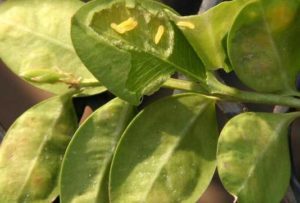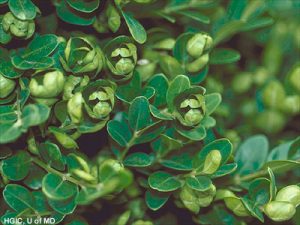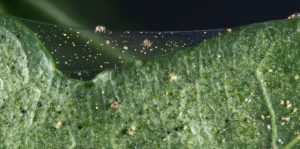Boxwoods are beautiful evergreen shrubs that have been in cultivation for hundreds of years – and with good reason. We love that they are dependably deer resistant and serve so many useful purposes in the landscape. We also love that they are easy to grow when planted in fertile, well-drained soil and protected from exposure. An annual trim and a light feeding is usually all they require. But boxwood plants aren’t free from problems. Boxwood Psyllid, Boxwood Leaf-miner and Spider Mites can infest boxwood and keep them from looking their best. Multiple growing seasons with a large infestation of leaf miner, in particular, will make boxwood look very unattractive and even decline in vigor. If you have boxwood in your garden, it’s a good idea to keep on the lookout for these tiny bugs and begin managing them before they get out of control.
 BOXWOOD LEAF MINERs are tiny orange, mosquito-like flies that live on and around boxwood plants. In late May-Early June, the adults emerge, having overwintered inside the leaves of the host plant. These pests are not strong fliers, so they usually hover a few inches from the host plants. Males and females emerge over a period of a week to 10 days and mate. Each female deposits up to 30 eggs inside the tender new growth and then dies within a few hours. Eggs hatch in a few weeks and the tiny orange larvae begin to feed on the tissue inside the leaf, causing a blister. The larvae overwinter in the leaf and resume feeding in spring. They pupate and then leave the blisters as adults, starting the process all over again. Affected leaves become tan and papery, usually shedding by August.
BOXWOOD LEAF MINERs are tiny orange, mosquito-like flies that live on and around boxwood plants. In late May-Early June, the adults emerge, having overwintered inside the leaves of the host plant. These pests are not strong fliers, so they usually hover a few inches from the host plants. Males and females emerge over a period of a week to 10 days and mate. Each female deposits up to 30 eggs inside the tender new growth and then dies within a few hours. Eggs hatch in a few weeks and the tiny orange larvae begin to feed on the tissue inside the leaf, causing a blister. The larvae overwinter in the leaf and resume feeding in spring. They pupate and then leave the blisters as adults, starting the process all over again. Affected leaves become tan and papery, usually shedding by August.
These pests are easy enough to identify: look closely at the leaves between fall and late spring. Blisters are evident in the leaves on the outside of the plant. If the leaves are broken open, the larvae can be seen with the naked eye or with the aid of light magnification. Populations can be managed by shearing off and discarding affected foliage before adults emerge in June. Scout for adults every day during the time that Weigela blooms. When adults are seen, spray the plants with a mild insecticide. Since adults emerge over a period of a days, a few applications might be best to get the best control. If July rolls around and you weren’t able shear or spray the adults, a stronger insecticide is needed to kill the larvae within the leaf.
 BOXWOOD PSYLLIDS are small insects resembling thrips or aphids. The adult stage has jumping legs and can spring out of the plants when disturbed. Adults appear in June and lay eggs between the leaf scales of immature buds in mid summer. The minute orange eggs overwinter there and hatch the following spring. Yellowish nymphs emerge at bud break in April or May. This stage has pointed mouth parts that are used to pierce the leaves and buds and suck out the sap. Their feeding distorts the new growth, causing the leaves to cup. The cupped leaves make a perfect shelter for the nymphs as they continue to feed and grow. Nymphs secrete a filamentous wax that accumulates in and around the cupped foliage. The wax clumps together in a fluffy mass that is easily blown into the air when the plants are brushed up against.
BOXWOOD PSYLLIDS are small insects resembling thrips or aphids. The adult stage has jumping legs and can spring out of the plants when disturbed. Adults appear in June and lay eggs between the leaf scales of immature buds in mid summer. The minute orange eggs overwinter there and hatch the following spring. Yellowish nymphs emerge at bud break in April or May. This stage has pointed mouth parts that are used to pierce the leaves and buds and suck out the sap. Their feeding distorts the new growth, causing the leaves to cup. The cupped leaves make a perfect shelter for the nymphs as they continue to feed and grow. Nymphs secrete a filamentous wax that accumulates in and around the cupped foliage. The wax clumps together in a fluffy mass that is easily blown into the air when the plants are brushed up against.
It’s easy to spot the presence of boxwood psyllid due to the conspicuous cupped foliage fluffy wax on the plants. Although this pest causes distortion of the foliage, the overall health of the plants is seldom affected. Because there is only one generation a year, it’s usually easy enough to control boxwood psyllid in a single season. If control does become necessary, it is best accomplished by targeting the nymph stage. Spray horticultural oil and/or insecticidal soap as new growth emerges. If new damage is noted, prune out affected foliage and discard to decrease populations.
Established boxwood plants will often have SPIDER MITES. The adults are miniscule, red/brown insects that vaguely resemble spiders. The first generation hatches in May from eggs that have overwintered on the underside of the leaves. The mites shed their outer skeleton several times as they grow into adults. They produce a fine webbing that gathers the shed exoskeletons. They have pointed mouthparts that pierce the leaf, allowing the mites to feed on the sap. Feeding occurs on both sides of the leaves causing white to light green flecking. Heavy infestations can cause yellowing and premature leaf drop. Controlling spider mites generally takes several applications of horticultural oil early in summer, as they have multiple generations a year.
 Identifying spider mites requires a little bit of detective work. If any kind of stippling or flecking is evident on the surface of boxwood leaves, suspect mites. Take a close look at the underside of the leaves. The shed exoskeletons and webbing can be seen with the naked eye, but the insects are so small it’s very difficult to see them without magnification. Pull a few affected leaves off the plant and tap them firmly on a white sheet of paper. Any mites will fall off onto the paper and they are much easier to see on the white background. Low populations of spider mites are often controlled by predatory insects in the environment naturally. However, larger infestations may cause leaves to turn brown and fall and do warrant control.
Identifying spider mites requires a little bit of detective work. If any kind of stippling or flecking is evident on the surface of boxwood leaves, suspect mites. Take a close look at the underside of the leaves. The shed exoskeletons and webbing can be seen with the naked eye, but the insects are so small it’s very difficult to see them without magnification. Pull a few affected leaves off the plant and tap them firmly on a white sheet of paper. Any mites will fall off onto the paper and they are much easier to see on the white background. Low populations of spider mites are often controlled by predatory insects in the environment naturally. However, larger infestations may cause leaves to turn brown and fall and do warrant control.
